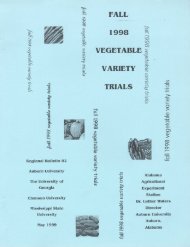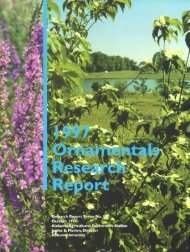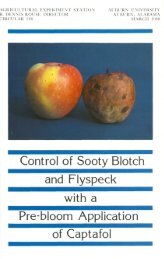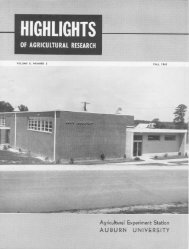MARKETING CHRISTMAS TREES - Auburn University Repository
MARKETING CHRISTMAS TREES - Auburn University Repository
MARKETING CHRISTMAS TREES - Auburn University Repository
You also want an ePaper? Increase the reach of your titles
YUMPU automatically turns print PDFs into web optimized ePapers that Google loves.
<strong>MARKETING</strong><br />
<strong>CHRISTMAS</strong> <strong>TREES</strong><br />
In R rvtzc RY1<br />
B. F. ALVORD, Statistician'<br />
THE <strong>CHRISTMAS</strong> TREE market of the United States is expanding.<br />
Total U.S. production and imports was reported to be approximately<br />
28 million trees in 1947 (7) and 38 million trees in 1955<br />
(8), an increase of about 34 per cent. Increase in population during<br />
this period was from 144 to 165 million people, or about 15<br />
per cent. Consequently, Christmas tree production and imports<br />
per capita increased about 15 per cent.<br />
Production plus imports are not the same as sales. However, in<br />
the Nation as a whole, the proportion sold may be expected to be<br />
sufficiently constant from year to year for changes in productionimports<br />
data to also represent changes in marketing.<br />
Now that electricity is almost universally available to homes<br />
and permits reasonably safe Christmas tree lighting, it would seem<br />
that the upward trend in use would at least keep pace with population<br />
increases. Changes in general economic conditions would,<br />
of course, cause fluctuations.<br />
Imports, largely from Canada, accounted for about a fourth of<br />
the total Christmas trees offered for sale in 1947 and about a third<br />
in 1955. Thus, imports from outside the United States increased<br />
by more than 50 per cent and outstripped both domestic production<br />
and population increases.<br />
Eastern red cedar, the South's most important contribution to<br />
the Christmas tree trade, represented about 10 per cent of domes-<br />
This project was supported by Hatch and State research funds and carried<br />
out as Alabama Project 567.<br />
2 The author is indebted to Robert Glover and Wayne Granberry for conducting<br />
interviews, to many persons of the Christmas tree trade for providing information<br />
upon which this study is based, and to G. I. Garin of the Forestry Department<br />
and to the staff of the Agricultural Economics Department for helpful suggestions.
















